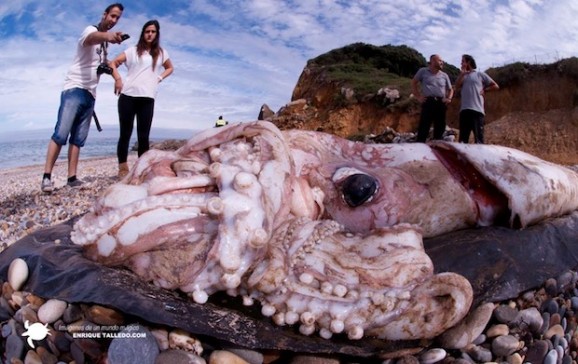Thirty-Foot Giant Squid Found In Spain
This article is more than 2 years old
 Walter White may have broken bad, but nature is breaking big. From giant killer hornets to massive dino farts to the recent discovery of a Cthulhu-esque giant squid on the beaches of Spain. Hey, they’re nice beaches — maybe the squid was just trying to get a little sun.
Walter White may have broken bad, but nature is breaking big. From giant killer hornets to massive dino farts to the recent discovery of a Cthulhu-esque giant squid on the beaches of Spain. Hey, they’re nice beaches — maybe the squid was just trying to get a little sun.
Giant squids are a bit like the Loch Ness Monster or Bigfoot — they’re fabled and feared, but with one important difference: they actually exist. Science and the internet say so, and now so do dozens of beachgoers in Cantabria, Spain who found more than driftwood and shells as they combed the sands.

The giant squid, whose eyeball is bigger than my head (the biggest eyeballs in nature, in fact), is about 30 feet long and weighs roughly 400 pounds. Damn. That’s ridiculous, frightening, and impressive all at once. The cephalopod corpse is now at the Maritime Museum of Cantabria, where some lucky employees got to clean the massive body and then store it in a freezer. Rumor has it they still regard the now frosty giant with suspicion and caution (and maybe a weapon in hand), just in case.
It’s not entirely clear what’s going to happen with this thing — it won’t fit on the mantle, that’s for sure. Apparently, there’s been some dispute about who owns the tentacle carcass, so the museum and the government (and maybe the Elder Things) have to sort through the details before they decide whether the squid will be displayed somewhere, dissected, or even cremated. Either of the first two options guarantee that the squid’s family will seek revenge, and cremation ensures that the squid will be reborn and then deliver vengeance itself, so I guess it’s six of one, a half-dozen of the other.
Despite being earth’s largest invertebrates, giant squids are notoriously sneaky and evasive. Sightings or recordings of them have historically been rare, though Japanese film crews got some great footage back in 2004, and earlier this year (see the video below), in addition to capturing a 24-foot-long live giant squid. Given that the squids live in the depths, usually from 1,000 – 3,000 feet below the surface, their carcasses rarely make it to shore intact. Until now, scientists have had to study the bits and pieces that wash up, so the chance to study such a specimen is a particularly exciting opportunity. Few museums or zoos can boast a giant squid carcass in their collections, so the Maritime Museum of Cantabria might opt for fortune and glory.
In addition to Cthulhu, giant squids feature prominently in classics such as Twenty Thousand Leagues Under the Sea and Moby-Dick. There’s also the Kraken, though those sea monsters are generally thought to live near the Arctic. Maybe they headed south to practice their Spanish?












